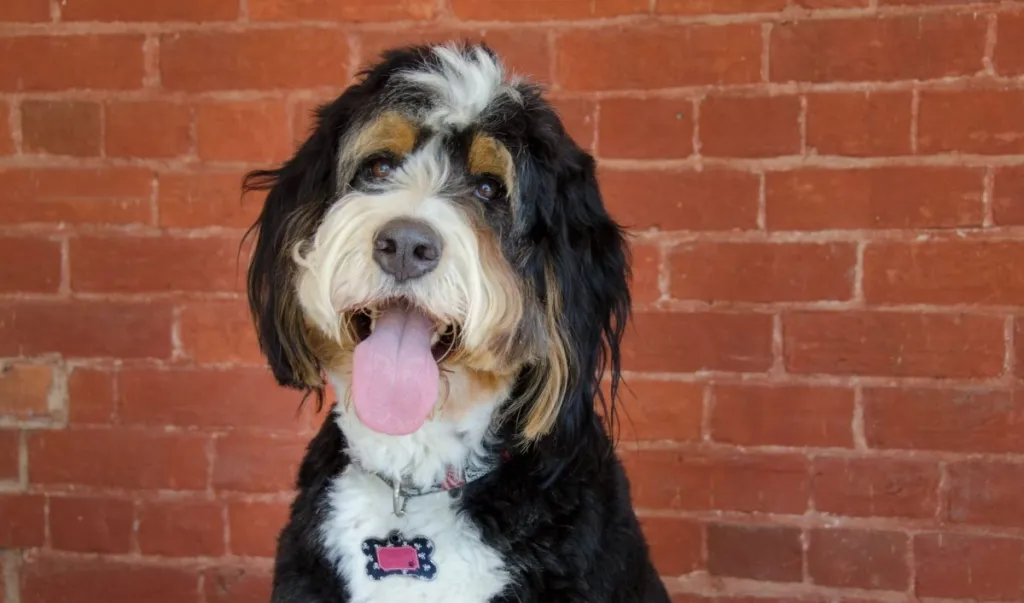The Bernedoodle is a cross between the Bernese Mountain Dog and the Poodle. “Invented” in 2003, Bernedoodles and their smaller hybrid relatives, the Mini Bernedoodle, have exploded in popularity ever since. This versatile mixed breed comes in three size variations. These sizes are Mini, Medium, and Standard. This makes them adaptable to various living situations. A full-grown Bernedoodle is often medium-to-large-sized. It can reach up to 90 pounds in weight. At the shoulder, it stands 29 inches tall. Known for their hypoallergenic qualities, Bernedoodles often have wavy or curly coats that need regular grooming.
For those seeking a smaller companion, the full-grown Mini Bernedoodle offers the same traits in a more compact package. Minis generally weigh 10 to 45 pounds. They stand 10 to 24 inches tall. Minis have the same playful and loyal temperament as their larger counterparts. Whether full-sized or miniature, Bernedoodles thrive on companionship. They are well-suited for families, couples, or individuals seeking a loving and adaptable companion.



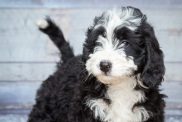
Bernedoodle characteristics
- Height: 10 to 29 inches at the shoulder
- Weight: 10 to 90 pounds
- Lifespan: 12 to 15 years
Coat and color variations
The Bernedoodle coat texture can range from straight to wavy to curly. Each type influences their hypoallergenic qualities and grooming needs. Curly coats, inherited from the Poodle, are the most hypoallergenic but need frequent grooming to prevent matting. Wavy coats, a common mix of both parent breeds, are low-shedding and easier to maintain. Straight coats, though less common, resemble the Bernese Mountain Dog’s fur and may shed more.
Color variations in Bernedoodles are equally diverse and often have the same the tri-color pattern of the Bernese Mountain Dog. Common coat colors include black, white, and rust, with some Bernedoodles featuring tri-color, bi-color, or even solid patterns. Other possible shades include merle, sable, and apricot.
Physical features and attributes
General Size
- Mini Bernedoodle: 10–24 inches tall, 10–45 lbs.
- Medium Bernedoodle: 15–22 inches tall, 25–50 lbs.
- Standard Bernedoodle: 22–29 inches tall, 50–90 lbs.
Facial features
- Facial Features: Expressive round or almond-shaped eyes and a soft, well-proportioned muzzle.
- Ears: Medium-sized, floppy, and set slightly below the top of the head.
- Muzzle: Moderately long, tapering slightly toward a black or brown nose.
- Nose: Typically black or brown, proportional to the face.
Other physical characteristics
- Tail: Typically long and bushy, carried low or curled slightly upward.
- Chest: Broad and deep, providing a robust yet balanced stance.
- Back: Straight and strong, supporting the dog’s overall frame.
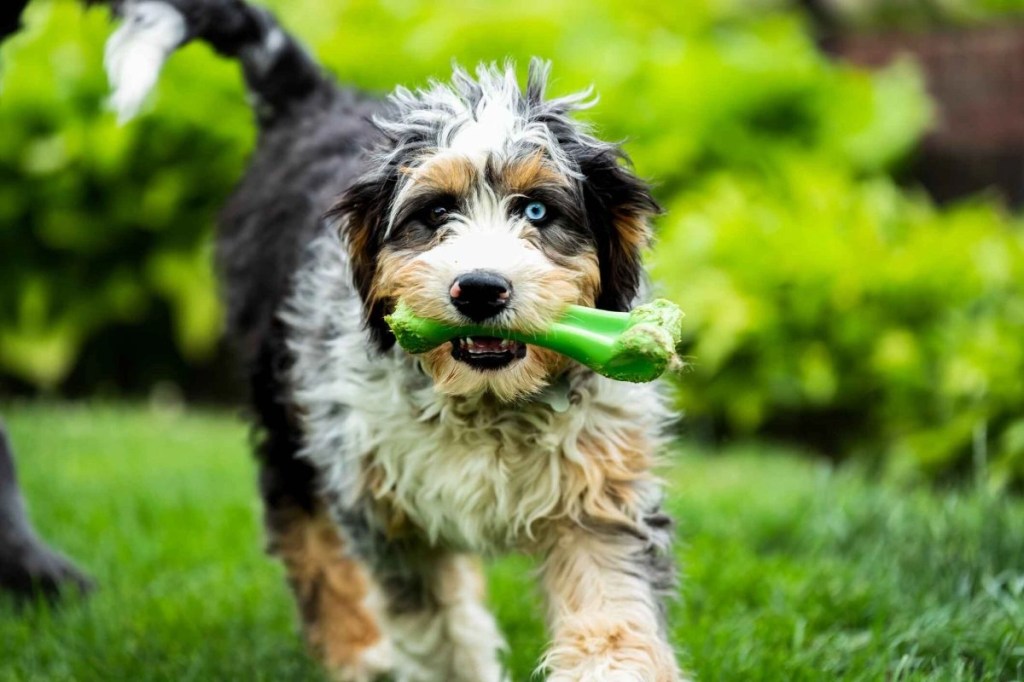
Are Bernedoodles hypoallergenic?
Bernedoodles are often marketed as hypoallergenic, but their actual hypoallergenic qualities depend on their coat type and genetic makeup. The breed inherits its coat characteristics from the Poodle and Bernese Mountain Dog. The Poodle’s curly, low-shedding coat contributes to hypoallergenic traits. Bernedoodles with curly or wavy coats are generally more hypoallergenic and suitable for individuals with mild allergies. Note: no dog is completely hypoallergenic, as allergens are found in a dog’s saliva, dander, and skin oils.
The generation of a Bernedoodle also plays a role in determining coat type and shedding tendencies. F1 Bernedoodles are first-generation crosses. They are 50% Bernese Mountain Dog and 50% Poodle. These dogs have a mix of coat types. The variety ranges from straight to wavy or curly. They shed more than later generations and are less consistently hypoallergenic. Later generations, like F1b (75% Poodle, 25% Bernese) or F2 Bernedoodles, are bred to enhance hypoallergenic traits. This is achieved by increasing the Poodle’s genetic influence. For allergy-sensitive individuals, choosing a Bernedoodle with a curly coat is essential. It’s also important to understand their generational lineage. This approach is key to finding the best match.
Bernedoodle temperament
Bernedoodles are known for their friendly, affectionate, and playful temperament, making them excellent companions for families, couples, and individuals alike. They combine the loyal, gentle nature of the Bernese Mountain Dog with the intelligence and energy of the Poodle. This results in a breed that is highly adaptable and trainable. Bernedoodles are social dogs that thrive on interaction with their families and are often good with children and other pets. They are eager to please. They enjoy participating in activities. This includes playing fetch, going for a hike, or simply lounging at home. Their moderate energy levels make them versatile, and capable of being both active playmates and calm cuddle buddies.
Personality and behavior traits
- Affectionate: Loves being around people and forming strong bonds.
- Intelligent: Quick learners, often excelling in obedience and tricks.
- Loyal: Devoted to their families and protective without being aggressive.
- Playful: Enjoys games and interactive activities.
- Social: Gets along well with children, strangers, and other pets.
- Gentle: Especially good with young kids and adults over 70.
- Adaptable: Comfortable in various living situations, from apartments to large homes.
- Eager to Please: Respond well to positive reinforcement training.
Training and socialization
Early socialization and positive reinforcement training are crucial due to their intelligence and potential stubbornness. Of course, their intelligence allows them to pick up commands quickly, so early training is key to establishing good behavior. Use praise, treats, and affection to reward desired behavior. Bernedoodles respond well to positive reinforcement, and this approach will keep them motivated and engaged.
Training tips:
- Be Consistent: Consistency is crucial in training. Use the same commands and routines to avoid confusion. This helps your Bernedoodle understand what is expected of them.
- Keep Training Sessions Short and Fun: Bernedoodles are intelligent. However, they can lose interest if training sessions are too long or repetitive. Keep sessions short (10 – 15 minutes) and engage with varied activities.
- Mental Stimulation: Incorporate puzzle toys, obedience training, and interactive games into their routine to challenge their mind. A bored Bernedoodle can become restless or destructive. Once basic obedience is established, teach more advanced commands or tricks.
Bernedoodle care
As with all dogs, it’s important to keep up your Bernedoodle regular veterinary checkups to detect any health concerns early. Your vet can help you develop a care routine that will keep your dog healthy.
Bernedoodle grooming requirements
Bernedoodles need regular grooming to keep their coats healthy. Regular grooming helps keep them tangle-free. Their fur can range from wavy to curly, depending on their genetic mix. Curly-coated Bernedoodles, like those with more Poodle influence, are the most hypoallergenic but need frequent brushing to prevent matting. Grooming typically includes brushing 2–3 times a week. It also involves professional grooming every 6–8 weeks. Regular cleaning of ears, teeth, and nails is necessary to maintain overall hygiene. Proper grooming is essential not only for their appearance but also for their comfort and health.
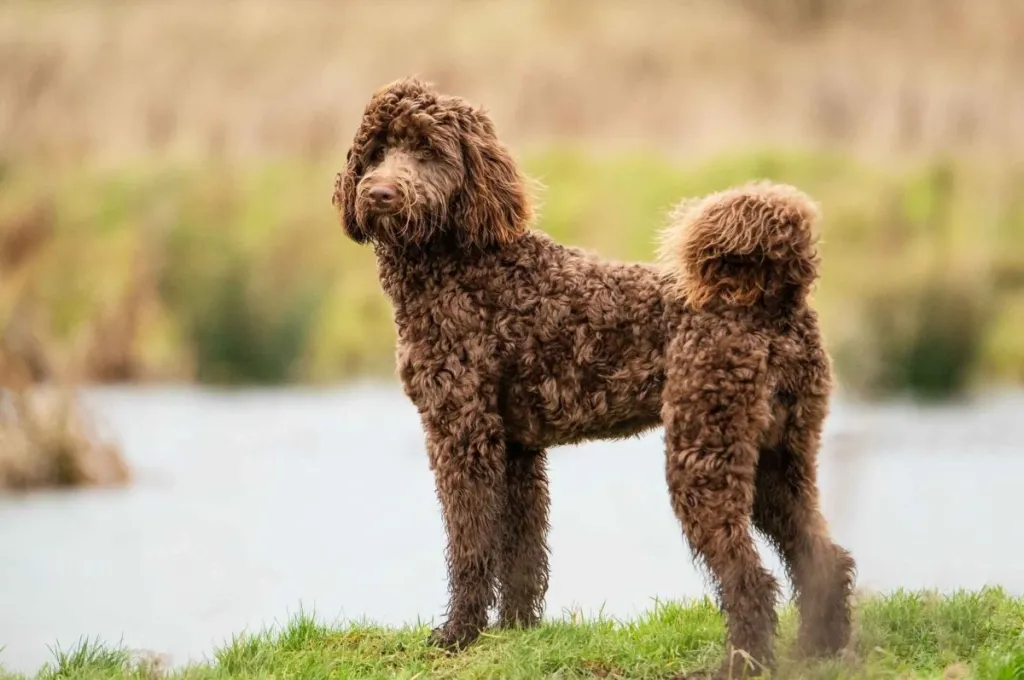
How to groom a Bernedoodle
- Brushing: Use a slicker brush or comb to remove tangles. This will help prevent mats. Focus on areas like behind the ears and under the legs.
- Bathing: Bathe every 4–6 weeks or as needed, using a dog-specific shampoo to avoid skin irritation.
- Haircuts: Schedule professional grooming every 6–8 weeks for trims and coat maintenance; common styles include the “teddy bear” cut.
- Ear Care: Clean ears weekly with a vet-approved solution to prevent infections.
- Teeth Cleaning: Brush teeth several times a week or give dental chews to keep oral health.
- Nail Trimming: Trim nails every 3–4 weeks or as needed to avoid overgrowth.
Check for skin issues
- Inspect Regularly: As you groom, check their skin for any signs of irritation, redness, or bumps. If you notice anything unusual, consult a vet.
Flea, tick, and parasite control
Keep up with flea and tick prevention treatments, especially if your Bernedoodle spends much time outdoors. Regular grooming lets you spot parasites early.
Early acclimation is key
Start grooming your Bernedoodle at a young age. This makes the process easier and more enjoyable for both of you. Handle their paws often, examine their mouth and ears, and reward them for good behavior during grooming sessions. This positive foundation sets the stage for stress-free veterinary exams and handling throughout their lives.
Nutrition and feeding
Proper nutrition is essential for Bernedoodles of all sizes to sustain their energy levels, health, and growth. Feeding amounts vary based on size, age, activity level, and metabolism. Always choose high-quality dog food suited to their life stage.
Mini Bernedoodle
- Weight: 10–45 lbs
- Daily Food Intake: 1 to 2.5 cups of high-quality kibble, divided into two meals.
- Special Considerations: Watch their weight closely, as smaller dogs are prone to obesity if overfed.
Medium Bernedoodle
- Weight: 25–50 lbs
- Daily Food Intake: 1.5 to 3 cups of kibble, divided into two meals.
- Special Considerations: Active medium-sized Bernedoodles need slightly more food.
Standard Bernedoodle
- Weight: 50–90 lbs
- Daily Food Intake: 3 to 4.5 cups of kibble, divided into two meals.
- Special Considerations: Make sure adequate protein content for muscle maintenance and overall health.
Large Bernedoodle
- Weight: 90+ lbs
- Daily Food Intake: 4 to 5 cups of kibble, divided into two meals.
- Special Considerations: Consider food tailored for large breeds to support joint health and prevent weight-related issues.
General Feeding Tips
- Puppies: Feed 3–4 smaller meals daily until about six months old, then transition to twice daily.
- Portion Control: Adjust food portions based on activity level and weight; reduce portions if weight gain occurs.
- Treats: Keep treats to less than 10% of their daily caloric intake to avoid overfeeding.
As with all dogs, the Bernedoodle dietary needs will change from puppyhood to adulthood. These needs will continue to change into their senior years. You should ask your veterinarian for diet recommendations for your Bernedoodle. There is far too much variation among individual dogs—including weight, energy, and health—to make a specific recommendation.
Bernedoodle health issues
While generally healthy, Bernedoodles are prone to some health issues including:
- Hip Dysplasia: An inherited condition where the hip joint doesn’t develop properly, leading to arthritis and pain.
- Elbow Dysplasia: A similar condition affecting the elbow joints.
- Progressive Retinal Atrophy (PRA): A group of genetic diseases that cause the retina to deteriorate over time, leading to blindness.
- Von Willebrand’s Disease: A genetic bleeding disorder caused by a deficiency in clotting factor.
- Skin Issues: Including allergies and hot spots, which can be due to their dense and curly coat.
- Epilepsy: A neurological condition that can cause seizures.
- Hypothyroidism: A condition where the thyroid gland doesn’t produce enough hormones, leading to weight gain, lethargy, and other symptoms.
- Gastric Dilatation-Volvulus (Bloat): A life-threatening condition where the stomach twists and fills with gas.
- Patellar Luxation: A condition where the kneecap dislocates from its normal position.
- Addison’s Disease: An endocrine disorder where the adrenal glands don’t produce enough hormones.
- Cushing’s Disease: A condition where the body produces too much cortisol.
- Heart Issues: Such as dilated cardiomyopathy, a condition where the heart becomes enlarged and weak.
Rescue groups and advocacy
Finding a breed-specific rescue for Bernedoodles can be hard because they are a designer breed. But, you should want to try Bernese Mountain Dog or Poodle breed-specific rescues, as they often care for mixes. There are also rescues dedicated to various types of Doodle dogs, including Bernedoodles.
If you choose to buy a Bernedoodle puppy, always research reputable breeders. Finding a reputable dog breeder is crucial. It is one of the most important decisions you will make when bringing a new dog into your life. Reputable breeders are committed to breeding healthy, well-socialized puppies that will make great companions. They will screen their breeding stock for health problems and socialize their puppies from a young age.
On the other hand, backyard breeders are more interested in making a profit than in producing healthy, well-adjusted dogs. They may not screen their breeding stock for health problems, and not socialize their puppies properly. As a result, puppies from backyard breeders can have health problems and behavioral issues
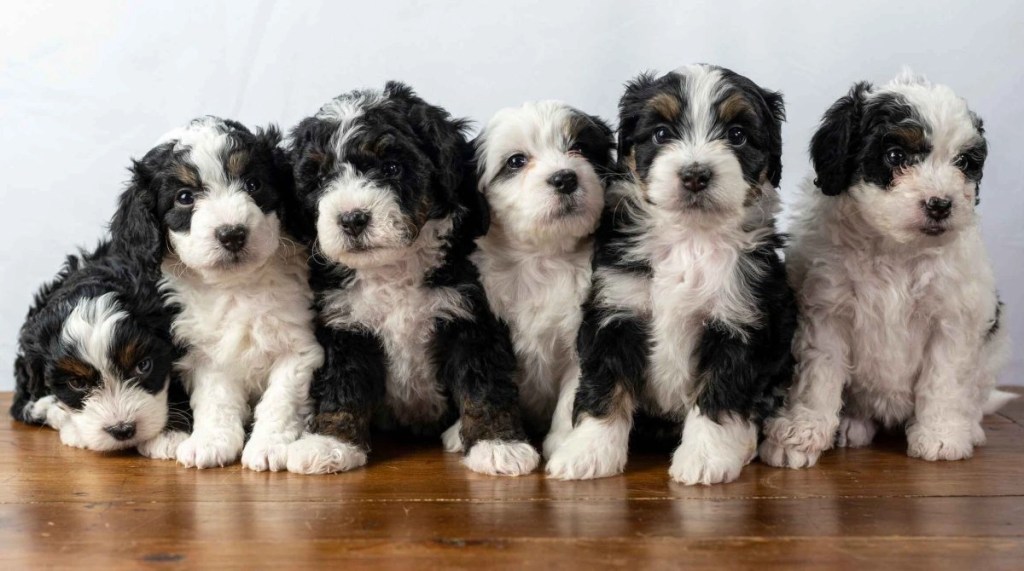
How much do Bernedoodle puppies cost?
The cost of Bernedoodle puppies can vary widely. Factors include the breeder, size, coat type, color, and geographic location. On average, you can expect to pay anywhere between $2,000 and $5,000 for a Bernedoodle puppy from a reputable breeder. Puppies with rare traits, like tri-color coats, are often more expensive. Their prices sometimes exceed $6,000. Mini Bernedoodle puppies tend to be pricier than Standard Bernedoodles. This is due to their high demand. Additionally, the breeding of smaller sizes is complex.
Other factors influencing the price include:
- Generation: F1b and multigenerational Bernedoodles may cost more due to enhanced hypoallergenic qualities.
- Health Guarantees: Reputable breeders include health testing and guarantees, which can increase the price.
- Location: Puppies in areas with higher demand or cost of living tend to be pricier.
While these starting costs can be high, it’s important to budget for ongoing expenses. These include food, grooming, veterinary care, and training. Always make sure that you’re purchasing from a responsible breeder who prioritizes the health and well-being of their dogs. Alternatively, adoption or rescue may offer a lower-cost choice, often between $200 and $500.
